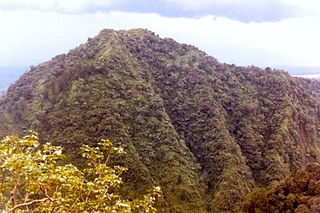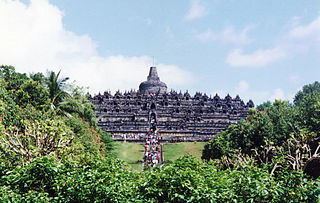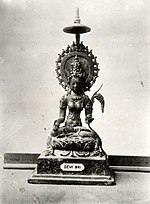
Central Java is a province of Indonesia, located in the middle of the island of Java. Its administrative capital is Semarang. It is bordered by West Java in the west, the Indian Ocean and the Special Region of Yogyakarta in the south, East Java in the east, and the Java Sea in the north. It has a total area of 33,750.37 km2, with a population of 36,516,035 at the 2020 Census making it the third-most populous province in both Java and Indonesia after West Java and East Java. The official population estimate in mid-2023 was 37,608,336 The province also includes a number of offshore islands, including the island of Nusakambangan in the south, and the Karimun Jawa Islands in the Java Sea.

Turgo is a small basaltic hill on the southern slopes of Mount Merapi, Indonesia, and is also known as Gunung Turgo or Mount Turgo. It is administratively located in Purwobinangun, Pakem, Sleman Regency, Special Region of Yogyakarta. Recent work suggests that the hill itself is older than the present volcanic cone of Gunung Merapi.

Javanese sacred places are locations on the Island of Java, Indonesia that have significance from either village level through to national level as sacred, and in most cases deserve visitation—usually within the context of ziarah regardless of the ethnicity or religion of the visitor. The dominant form for many places is a sacred grave, or a place associated with persons considered to have special attributes in the past—like Wali Sanga or Royalty.

The Wali Songo are revered saints of Islam in Indonesia, especially on the island of Java, because of their historic role in the spread of Islam in Indonesia. The word wali is Arabic for "trusted one" or "friend of God", while the word sanga is Javanese for the number nine.
Sunan Kudus, founder of Kudus, is one of the Wali Sanga, of Java, Indonesia to whom the propagation of Islam amongst the Javanese is attributed.

Sunan Giri, and Muhammad Ainul Yakin is considered one of the Wali Sanga in Indonesia. His family is from Hussani Sayid, no historical evidence that he is from Qadiri family

A candi is a Hindu or Buddhist temple in Indonesia, mostly built during the Zaman Hindu-Buddha or "Hindu-Buddhist period" between circa the 4th and 15th centuries.

Kedu Plain, also known as Progo River Valley, is the fertile volcanic plain that lies between the volcanoes Mount Sumbing and Mount Sundoro to the west, and Mount Merbabu and Mount Merapi to the east. It roughly corresponds to the present-day Magelang and Temanggung Regency of Central Java, Indonesia.

The Demak Sultanate was a Javanese Muslim state located on Java's north coast in Indonesia, at the site of the present-day city of Demak. A port fief to the Hindu-Buddhist Majapahit kingdom thought to have been founded in the last quarter of the 15th century, it was influenced by Islam brought by Muslim traders from China, Gujarat, Arabia and also Islamic kingdoms in the region, such as Samudra Pasai, Malacca and Bani (Muslim) Champa. The sultanate was the first Muslim state in Java, and once dominated most of the northern coast of Java and southern Sumatra.
Sunan Ampel was one the nine revered Javanese Muslim saints, or Wali Songo, credited with the spread of Islam in Java. According to local history, around Demak the mosque of Demak Masjid Agung Demak was built by Sunan Ampel in 1479 CE, but other sources attributed the construction of the mosque to Sunan Kalijaga.
Sunan is the shorter version of "Susuhunan", both used as an honorific on the island of Java, Indonesia.
Sunan Muria is, according to the Babad Tanah Jawi manuscripts, one of the nine Wali Sanga involved in propagating Islam in Indonesia.
Sunan Sitijenar is, according to the Babad Tanah Jawi manuscripts, one of the nine Wali Sanga to whom Indonesian legend attributes the establishment of Islam as the dominant religion among the Javanese, Indonesia's largest ethnic group.

Gedong Songo is a group of Hindu temples located near Bandungan, Semarang Regency, in north Central Java, Indonesia. It is variously dated between the 8th and 9th-century. Built around a 1,270 metres (4,170 ft) hill near Mount Ungaran, it consist of five Gedong – two on the east side of the hill, two towards the north and one to the west. These total nine temples, all dedicated to Shiva and Parvati. The Gedong Songo complex is one of 110 sites in central Java with Hindu temple structures or remains, and one of 21 in Semarang area, states Veronique Degroot.

Javanisation or Javanization is the process in which Javanese culture dominates, assimilates, or influences other cultures in general. The term "Javanise" means "to make or to become Javanese in form, idiom, style, or character". This domination could take place in various aspects; such as cultural, language, politics and social.

Ketupat, or kupat, or tipat is a Javanese rice cake packed inside a diamond-shaped container of woven palm leaf pouch. Originating in Indonesia, it is also found in Brunei, Malaysia, Singapore, southern Philippines, southern Thailand, Cambodia and Laos. It is commonly described as "packed rice", although there are other types of similar packed rice such as lontong and bakchang.

Islam is the most common religion in the Indonesian province of East Java, embraced by 96.7% of the whole population. Throughout its history, East Java has been considered one of the heartlands of Islam in Indonesia; the province experienced one of the earliest proliferations of Islam, as well as the establishment of the largest Islamic mass organization in Indonesia, Nahdlatul Ulama.

The Red Mosque of Panjunan is a Javanese mosque located in the village of Panjunan, Cirebon Regency, West Java, Indonesia. This 15th-century mosque with its Hindu architecture typical of Java is one of the oldest mosque in Indonesia.
Panembahan Senapati, formally styled Panembahan Senapati ing Ngalaga Sayyidin Panatagama, was the founder of the Mataram Sultanate.













